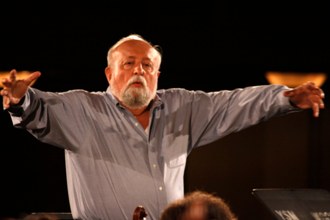Krzysztof Penderecki - Polskie Requiem (1986)
Krzysztof Penderecki - Polskie Requiem (1986)

1. Requiem Aeternam : Requiem Aeternam Dona Eis(3'52)
2. Kyrie : Kyrie Eleison(4'34)
3. Dies Irae : Dies Irae, Dies Illa(1'41)
4. Dies Irae : Tuba Mirum Spargens Sonum(1'48)
5. Dies Irae : Mors Stupebit Et Natura(6'08)
6. Dies Irae : Quid Sum Miser Tunc Dicturus?(4'26)
7. Dies Irae : Rex Tremendae Majestatis(2'02)
8. Dies Irae : Recordare Jesu Pie(10'49)
9. Dies Irae : Ingemisco Tamquam Reus(11'12)
10 Dies Irae : Lacrimosa Die Silla(5'18)
11 Agnus Dei, Qui Tollis Peccata Mundi(8'24)
12 Lux Aeterna, Luceat Eis(4'26)
13 Libera Me Domine, De Morte Eterna(8'37)
14 Swiety Boze(5'14)
15 Libera animas(6'11)
Mariana Nicolesco - soprano
Grazyna Winogrodzka – alto
Henryk Grychnik – tenor
Leonard Mroz - bass
Choeur et Orchestre de la la Philarmonie de Cracovie
Krzysztof Penderecki – conductor
Live recording France musique 11/2/1986 in Saint-Eustache-Paris
It all began with Lacrimosa, a several-minute-long lament for a soprano voice, choir, and orchestra, which Krzysztof Penderecki composed on the request of Lech Wa³êsa. The work was presented on 16th December 1980 in Gdañsk at the unveiling of the monument to the shipyard workers murdered 10 years earlier by communists. Asked about the world premiere, the composer reminisces: “It was an extraordinary experience. The concert, or rather the playing of the recording of my piece was just a small part of the ceremony. A million people were reportedly gathered at the foot of the monument in falling sleet. With weather conditions like that, the spotlights provided uncanny lighting. A few days later, Lech Wa³êsa phoned me saying “Mr Composer, your colleagues refused, would you agree to write a piece for the ceremony of the unveiling of the monument to the murdered shipyard workers?” They refused because they were afraid; the event was not favourably looked upon by the powers that be. I agreed, and wrote Lacrimosa in the matter of just a few days. Antoni Wit recorded it with the Polish Radio Choir and Orchestra in Kraków, with Jadwiga Go dulanka as the soloist, and the recording was played in Gdañsk.
Several minutes long, highly melancholic and lyrical, Lacrimosa with its memorable introduction of the soprano became the germ of the monumental – in terms of both form and content – Polish Requiem, one of the most extraordinary pieces in not only the oeuvre of Krzysztof Penderecki, but also the history of Polish music. There is no other work that is so strongly bound to the historical and political context and the time when it originated. The symbolic layer was emphasised with significant dedications, binding the ideas of the successive movements to specific events. The Polish Requiem was years in the making, gradually taking its final shape. Even long after composing Lacrimosa, Penderecki did not intend to include it in a greater whole, even though – as he repeatedly admitted – the idea of writing a funeral mass came about in his head much earlier. Laughing, he recalls that at the time he was afraid of the superstition that, much like in the case of Mozart, the Requiem could become the last of his pieces. He was waiting for an appropriate moment, and lo and behold the political situation in Poland of the early 1980s made him decide on a mass. “And I succeeded in surviving my Requiem,” the composer says.
Zaczęło się od Lacrimosy, kilkuminutowego lamentu na głos sopranowy, chór i orkiestrę, który Krzysztof Penderecki skomponował na prośbę Lecha Wałęsy. Utwór zaprezentowano 16 grudnia 1980 roku w Gdańsku z okazji odsłonięcia pomnika stoczniowców zamordowanych przez komunistów 10 lat wcześniej. Kompozytor, pytany o prawykonanie, wspomina: – To było niezwykłe przeżycie. Koncert, a właściwie odtworzenie nagrania mojego utworu było tylko fragmentem uroczystości. Pod pomnikiem zebrał się podobno milion osób, padał deszcz ze śniegiem, reflektory dawały przy tej pogodzie niesamowite światło. Kilka dni wcześniej zadzwonił do mnie Lech Wałęsa: „Panie kompozytorze, inni pana koledzy odmówili, czy pan zgodzi się napisać utwór na uroczystość odsłonięcia pomnika poległych stoczniowców?”. Odmówili, bo się bali, to nie było wydarzenie dobrze widziane przez władze. Ja się zgodziłem i napisałem Lacrimosę dosłownie w ciągu kilku dni. Antoni Wit nagrał ją z Chórem i Orkiestrą Polskiego Radia w Krakowie, z Jadwigą Gadulanką jako solistką i to właśnie nagranie odtworzono w Gdańsku
Kilkuminutowa, pełna melancholii i liryczna Lacrimosa, z zapadającą w pamięć introdukcją sopranu, stała się zaczątkiem monumentalnego w formie i treści Polskiego Requiem, jednego z najbardziej niezwykłych utworów – nie tylko w dorobku Krzysztofa Pendereckiego, ale i w historii polskiej muzyki. Nie ma drugiego dzieła tak bardzo związanego z kontekstem historyczno-politycznym i czasem, w którym powstawało. Warstwa symboliczna podkreślona została znaczącymi dedykacjami, wiążącymi ideę kolejnych części z konkretnymi wydarzeniami. Polskie Requiem powstawało latami, stopniowo nabierając pełnego kształtu. Jeszcze długo po skomponowaniu Lacrimosy Penderecki nie myślał o włączeniu jej w większe dzieło, choć – jak wielokrotnie przyznawał – pomysł napisania mszy żałobnej pojawił się w jego głowie dużo wcześniej. Wspomina z humorem, że obawiał się wtedy przesądu, iż podobnie jak w przypadku Mozarta, requiem mogłoby stać się ostatnim z jego utworów. Czekał na odpowiedni moment, i oto sytuacja polityczna w Polsce na początku lat 80. sprawiła, że zdecydował się na mszę. – Udało mi się przeżyć moje Requiem – mówi kompozytor. --- krzysztofpenderecki.eu
download: uploaded anonfiles mega mixturecloud yandex 4shared mediafire ziddu








